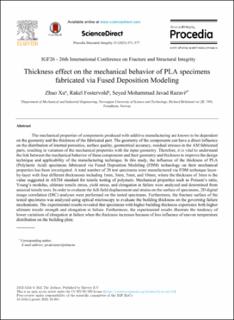| dc.description.abstract | The mechanical properties of components produced with additive manufacturing are known to be dependent on the geometry and the thickness of the fabricated part. The geometry of the components can have a direct influence on the distribution of internal porosities, surface quality, geometrical accuracy, residual stresses in the AM fabricated parts, resulting in variation of the mechanical properties with the input geometry. Therefore, it is vital to understand the link between the mechanical behavior of these components and their geometry and thickness to improve the design technique and applicability of the manufacturing technique. In this study, the influence of the thickness of PLA (Polylactic Acid) specimens fabricated via Fused Deposition Modeling (FDM) technology on their mechanical properties has been investigated. A total number of 20 test specimens were manufactured via FDM technique layer-by-layer with four different thicknesses including 1mm, 3mm, 5mm, and 10mm, where the thickness of 3mm is the value suggested in ASTM standard for tensile testing of polymers. Mechanical properties such as Poisson’s ratio, Young’s modulus, ultimate tensile stress, yield stress, and elongation at failure were analyzed and determined from uniaxial tensile tests. In order to evaluate the full-field displacement and strains on the surface of specimens, 2D digital image correlation (DIC) analyses were performed on the tested specimens. Furthermore, the fracture surface of the tested specimens was analyzed using optical microscopy to evaluate the building thickness on the governing failure mechanisms. The experimental results revealed that specimens with higher building thickness experience both higher ultimate tensile strength and elongation at failure. Furthermore, the experimental results illustrate the tendency of lower variations of elongation at failure when the thickness increases because of less influence of uneven temperature distribution on the building plate. | en_US |

